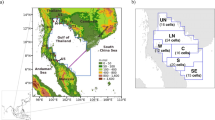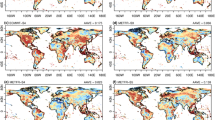Abstract
Wind is one of the crucial renewable energy sources which is expected to bring solutions to the challenges of clean energy and the global issue of climate change. Several linear and nonlinear multivariate techniques have been used to predict the stochastic character of wind speed. Wind speed forecast with good accuracy has a positive impact on the reduction of electricity system cost and is essential for the effective power grid management. Over the past years, few studies have been done on the assessment of teleconnections and its possible effects on the long-term wind speed variability in the UAE region. In this study, nonlinear canonical correlation analysis (NLCCA) method is applied to study the relationship between global climate oscillation indices and meteorological variables, with a major emphasis on wind speed of UAE. The wind dataset was obtained from six ground stations spread within the country. The first mode of NLCCA captured the nonlinear mode of the teleconnection indices at different seasons, showing the symmetry between the warm states and the cool states. The strength of the nonlinear canonical correlation between the two sets of variables varies with the lead/lag time. The performance of the models is assessed by calculating error indices such as the relative root mean square error (rRMSE) and relative mean absolute error (MAER). The results indicated that NLCCA models provide more accurate information about the nonlinear intrinsic behavior of the dataset of variables than linear canonical correlation analysis (CCA) model in terms of the correlation and root mean square error.








Similar content being viewed by others
References
Almazroui M (2011) Temperature variability over Saudi Arabia and its association with global climate indices. J King Abdulaziz Univ-Meteorol Environ Arid Land Agric Sci 23:85–108. https://doi.org/10.4197/Met.23-1.6
Burton T, Sharpe D, Jenkins N, Bossanyi E (2001) Wind energy handbook. John Wiley & Sons
Charabi Y, Abdul-Wahab SA (2009) Synoptic aspects of the summer monsoon of Southern Oman and its global teleconnections. J Geophys Res-Atmos. https://doi.org/10.1029/2008JD010234
Chokmani K, Ouarda TBMJ, Stuart H, Hosni Ghedira M, Gingras H (2008) Comparison of ice-affected streamflow estimates computed using artificial neural networks and multiple regression techniques. J Hydrol 349:383–396. https://doi.org/10.1016/j.jhydrol.2007.11.024
Dauxois J, Nkiet GM (1998) Nonlinear canonical analysis and independence tests. Ann Stat 26(4):1254–1278
Hsieh WW (2000) Nonlinear canonical correlation analysis by neural networks. Neural Netw 13(10):1095–1105
Kramer MA (1991) Nonlinear principal component analysis using autoassociative neural networks. AICHE J 37(2):233–243
Kumar KN, Ouarda TBMJ (2014) Precipitation variability over UAE and global SST teleconnections. J Geophys Res 119:10,313–10,322. https://doi.org/10.1002/2014JD021724
Kumar S, Martin EB, Morris AJ (2002) Non-linear canonical correlation analysis using a RBF networks. In ESANN, 507–12. Citeseer
Lai PL, Fyfe C (1999) A neural implementation of canonical correlation analysis. Neural Netw 12(10):1391–1397
Landberg L, Watson SJ (1994) Short-term prediction of local wind conditions. Bound-Layer Meteorol 70(1–2):171–195
Li S, Wunsch DC, O’Hair E, Giesselmann MG (2001) Comparative analysis of regression and artificial neural network models for wind turbine power curve estimation. J Solar Energy Eng Trans ASME 123:327–332. https://doi.org/10.1115/1.1413216
Naizghi MS, Ouarda TBMJ (2016) Teleconnections and analysis of long-term wind speed variability in the UAE. Int J Climatol. https://doi.org/10.1002/joc.4700
Nasrallah HA, Balling RC, Selover NJ, Vose RS (2001) Development of a seasonal forecast model for Kuwait winter precipitation. J Arid Environ 48:233–242. https://doi.org/10.1006/jare.2000.0746
Nazemosadat MJ, Samani N, Barry DA (2006) ENSO forcing on climate change in Iran: precipitation analysis. Iran J Sci Technol TransB: Eng 30(ECOL-ARTICLE-2007-006):555–565
Pinson P (2013) Wind energy: forecasting challenges for its operational management. Stat Sci 28(4):564–585
Author information
Authors and Affiliations
Corresponding author
Additional information
Responsible Editor: Zhihua Zhang
Rights and permissions
About this article
Cite this article
Woldesellasse, H., Marpu, P.R. & Ouarda, T. Long-term forecasting of wind speed in the UAE using nonlinear canonical correlation analysis (NLCCA). Arab J Geosci 13, 962 (2020). https://doi.org/10.1007/s12517-020-05981-9
Received:
Accepted:
Published:
DOI: https://doi.org/10.1007/s12517-020-05981-9




